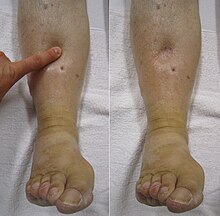Oedema - Simple English Wikipedia, the free encyclopedia


Oedema (U.S. edema)[1] is dropsy. It was usually called dropsy until about the middle of the 20th century.
It is a medical condition, and a sign or symptom. It is swelling caused when fluid leaks out of the body's capillaries into the tissues. The fluid builds up and gets trapped in the tissues around the leaking blood vessels.[2] This causes swelling. If there is enough swelling, oedema can be seen from outside of the skin.
Oedema can happen in any part of the body However, it is easiest to see in the arms and legs, including the hands, ankles, and feet.[2] Oedema in the arms and legs is called peripheral oedema.[3]
Pulmonary oedema is fluid in the lungs.[4] Pulmonary oedema is dangerous because having fluid in the lungs makes breathing difficult. If pulmonary oedema gets bad enough, a person can drown in the fluid.[5]
Oedema in the abdomen is called ascites.[6]
Signs and symptoms
[change | change source]Some of the signs and symptoms of oedema are:[2]
- Swelling or puffiness right under the skin
- Skin that looks stretched or shiny
- Changes in skin color
- Aching arms and legs
- Stiff joints
- Weight gain or weight loss
- Blood pressure and pulse rate that are higher than normal
Oedema in the lungs (pulmonary edema) can make it hard to breathe or cause chest pain.[5]
Causes
[change | change source]Many things can cause oedema. When oedema is mild (not very serious), the most common causes are:[2][7]
- Eating too much salt
- Staying still for long periods of time
- Pregnancy
- Side effects from some medication
However, oedema can also be a sign of serious disease.[2][7] Diseases that can cause edema include:
- Congestive heart failure (CHF). In CHF, the heart does not pump hard enough to send blood throughout the body. This can cause blood to back up in the arms and legs (causing peripheral oedema). It can also cause fluid to back up in the lungs (pulmonary oedema).[8]
- Liver damage (cirrhosis). Liver damage can cause fluid to back up in the abdomen (ascites) and the legs.[9]
- Kidney problems. The kidneys' job is to remove extra fluid from the blood. If the kidneys are not doing this job, the fluid builds up in other parts of the body.[7]
- Deep vein thrombosis (DVT). A DVT is a blood clot inside one of the deep veins in the body, usually deep inside the legs. Oedema in the legs is one sign of DVT.[10]
- Varicose veins.[2]
Treatment
[change | change source]If oedema is not very serious, it often goes away on its own. If a person has mild oedema in an arm or leg, they can often make oedema go away quicker by keeping the arm or leg raised above the level of the heart.[2]
If oedema is more serious, it is treated with medicines called diuretics. These are medicines which help the body get rid of extra fluid by urinating it out.[7]
If oedema is caused by a disease, that disease needs to be treated.[2]
References
[change | change source]- ↑ Note on spelling and pronunciation: The origin of the term is Greek. The O is silent, and it is pronounced as a long E (Ē).
- ↑ 2.0 2.1 2.2 2.3 2.4 2.5 2.6 2.7 "Edema". Mayo Clinic. 2014-09-19. Retrieved 2015-01-03.
- ↑ Dugdale, David (2013-04-21). "Foot, leg, and ankle swelling". Medline Plus. National Institutes of Health. Retrieved 2015-01-03.
- ↑ Chen, Michael (2014-05-13). "Pulmonary edema". Medline Plus. National Institutes of Health. Retrieved 2015-01-03.
- ↑ 5.0 5.1 Ware LB, Matthay MA (December 2005). "Clinical practice. Acute pulmonary edema". N. Engl. J. Med. 353 (26): 2788–96. doi:10.1056/NEJMcp052699. PMID 16382065.
- ↑ Longstreth, George (2013-10-13). "Ascites". Medline Plus. National Institutes of Health. Retrieved 2015-01-03.
- ↑ 7.0 7.1 7.2 7.3 "Edema". American Academy of Family Physicians. 2014-02-01. Archived from the original on 2015-03-09. Retrieved 2015-01-03.
- ↑ "About Heart Failure". American Heart Association. 2012-08-20. Retrieved 2015-01-03.
- ↑ "Cirrhosis". Mayo Clinic. 2014-08-16. Retrieved 2015-01-03.
- ↑ "Deep Vein Thrombosis". Centers for Disease Control and Prevention. 2014-12-10. Retrieved 2015-01-03.


 French
French Deutsch
Deutsch